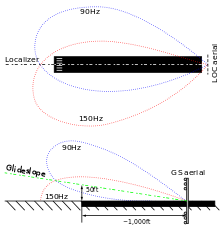Final approach (aeronautics)

Four aircraft on final approach at London's Heathrow Airport
A final approach (also called final leg and final approach leg[1]) is the last leg in an aircraft's approach to landing, when the aircraft is lined up with the runway and descending for landing.[2] In aviation radio terminology, it is often shortened to "final".
In a standard airport landing pattern, which is usually used under visual meteorological conditions (VMC), aircraft turn from base leg to final within one-half to two miles of the airport. For instrument approaches, as well as approaches into a controlled airfield under visual flight rules (VFR), often a "straight-in" final approach is used, where all the other legs are dispensed with. Straight-in approaches are discouraged at non-towered airports in the United States.[3]
Contents
1 Approach slope
2 Final approach point
3 References
4 External links
Approach slope
An approach slope is the path that an airplane follows on its final approach to land on a runway. It takes its name from the fact that this path is ideally a gentle downward slope. A commonly used approach slope is 3° from the horizontal. However, certain airports have steeper approach paths based on topography, buildings, or other considerations. London City Airport, for example, has a 5.5° approach, and only aircraft that can maintain such an approach are permitted to use the airport.[4]

A composite image of an Alliance Airlines Fokker 70 on final approach at Christmas Island Airport, illustrating the approach slope to the runway
The term glide slope is often applied to mean approach slope although to be correct, glide slope applies to the vertical guidance element of the Instrument Landing System.[2]
Final approach point

The glideslope and localizer radio beams of an ILS guide an aircraft down its final approach path
The final approach point on an instrument approach with vertical guidance is glide slope or glide path intercept at the lowest published altitude (ICAO definition).[citation needed]
In the US, it is called the final approach fix (FAF) and marked on a NACO IAP by a lightning bolt symbol and on a Jeppesen terminal chart by the end of the glide slope path symbol. It is the point in space where the final approach segment begins on the instrument approach; the final approach point on a non-precision approach is marked by a maltese cross symbol. In the US, where the approach navigation aid is on the field and there is no depicted, the final approach point is "where the aircraft is established inbound on the final approach course from the procedure turn and where the final approach descent may be commenced".[5][6]
References
^ "Aviation Glossary - F". Transport Canada. 2012-03-14. Archived from the original on 2015-10-18. Retrieved 2012-08-21..mw-parser-output cite.citation{font-style:inherit}.mw-parser-output .citation q{quotes:"""""""'""'"}.mw-parser-output .citation .cs1-lock-free a{background:url("//upload.wikimedia.org/wikipedia/commons/thumb/6/65/Lock-green.svg/9px-Lock-green.svg.png")no-repeat;background-position:right .1em center}.mw-parser-output .citation .cs1-lock-limited a,.mw-parser-output .citation .cs1-lock-registration a{background:url("//upload.wikimedia.org/wikipedia/commons/thumb/d/d6/Lock-gray-alt-2.svg/9px-Lock-gray-alt-2.svg.png")no-repeat;background-position:right .1em center}.mw-parser-output .citation .cs1-lock-subscription a{background:url("//upload.wikimedia.org/wikipedia/commons/thumb/a/aa/Lock-red-alt-2.svg/9px-Lock-red-alt-2.svg.png")no-repeat;background-position:right .1em center}.mw-parser-output .cs1-subscription,.mw-parser-output .cs1-registration{color:#555}.mw-parser-output .cs1-subscription span,.mw-parser-output .cs1-registration span{border-bottom:1px dotted;cursor:help}.mw-parser-output .cs1-ws-icon a{background:url("//upload.wikimedia.org/wikipedia/commons/thumb/4/4c/Wikisource-logo.svg/12px-Wikisource-logo.svg.png")no-repeat;background-position:right .1em center}.mw-parser-output code.cs1-code{color:inherit;background:inherit;border:inherit;padding:inherit}.mw-parser-output .cs1-hidden-error{display:none;font-size:100%}.mw-parser-output .cs1-visible-error{font-size:100%}.mw-parser-output .cs1-maint{display:none;color:#33aa33;margin-left:0.3em}.mw-parser-output .cs1-subscription,.mw-parser-output .cs1-registration,.mw-parser-output .cs1-format{font-size:95%}.mw-parser-output .cs1-kern-left,.mw-parser-output .cs1-kern-wl-left{padding-left:0.2em}.mw-parser-output .cs1-kern-right,.mw-parser-output .cs1-kern-wl-right{padding-right:0.2em}
^ ab Crane, Dale: Dictionary of Aeronautical Terms, third edition, page 213 and 241. Aviation Supplies & Academics, 1997.
ISBN 1-56027-287-2
^ "Operations at Non-Towered Airports" (PDF). AOPA. Archived from the original (PDF) on 13 January 2006.
^ "London City Airport - Airport Operations". Lcacc.org. Archived from the original on 2012-03-05. Retrieved 2012-08-21.
^ "Pilot/Controller Glossary. "F"". FAA. 2013-03-07. Retrieved 2013-04-25.
^ "Instrument Procedures Handbook (FAA-H-8261-1A). Chapter 5" (PDF). FAA. 2007.
External links
 Media related to Aircraft on final approach at Wikimedia Commons
Media related to Aircraft on final approach at Wikimedia Commons